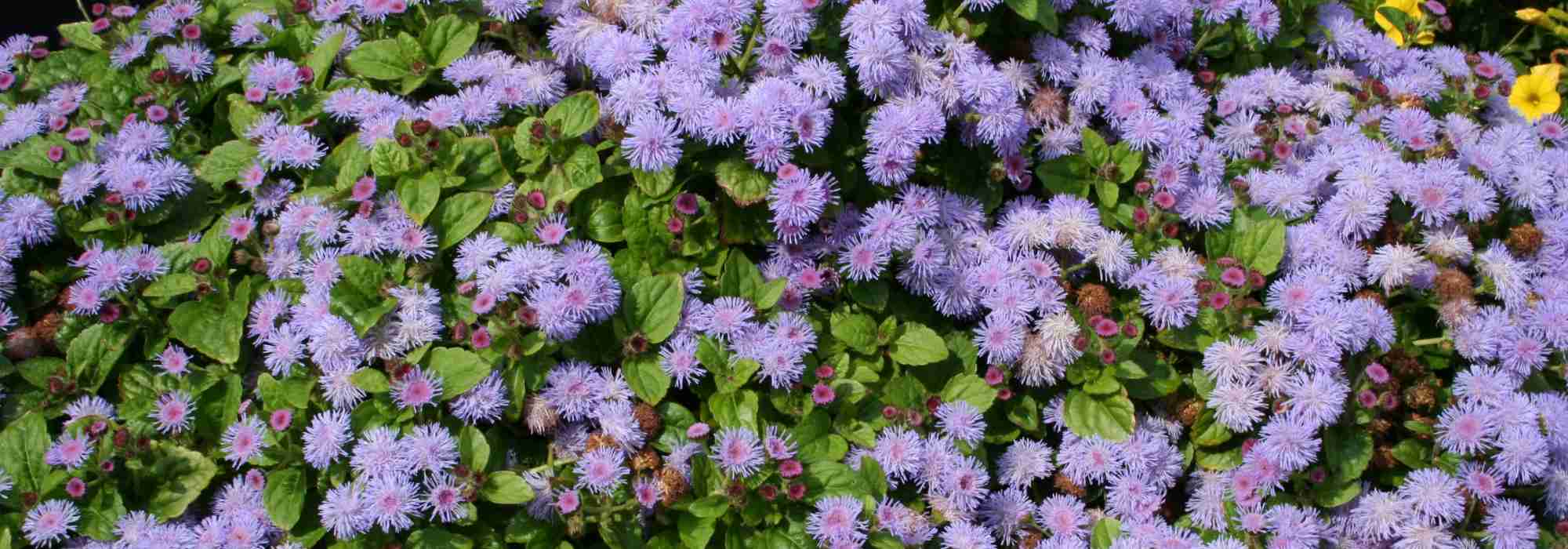
Ageratum, Mexican ageratum: sowing, planting, care
Contents
Ageratum houstonianum in a nutshell
- Very floriferous, Ageratum houstonianum (syn.mexicanum) offers 6 months of flowers, from spring to autumn
- It blooms profusely in large clusters of small fluffy pompom-like flowers, often blue, sometimes white, pink or mauve
- This frost-tender perennial is most often grown as an annual
- It grows rapidly in full sun in light, well-drained and cool soils, provided you give regular watering!
- It is one of those hassle-free annuals, easy to grow in borders, beds or rockeries as well as in window boxes or pots on a balcony
A word from our expert
Ageratum houstonianum (syn. mexicanum) also known as “Mexican ageratum”, “Blue Ageratum” or “Célestine” is a perennial plant not very hardy, usually grown as an annual in our gardens.
It’s one of the most beautiful blue flowers for summer displays!
From dwarf varieties such as Ageratum ‘Blue Danube’ with pure blue flowers, to white ageratum, and right up to one of the tallest, ageratum ‘Red Sea’ with dark red flowers, all are appreciated for their flowering, which lasts from spring through to first frosts.
A staple of public landscaping, ageratum blooms in umbels of small feathery heads that also fit perfectly in front of borders or as edging in gardens or even in pots on terraces.
Fresh and easy, ageratum is simple to grow in sun, in any good, well-drained garden soil that stays cool in summer: ageratum only requires regular watering to flower profusely.
Discover our ageratum collection, this weather-resistant annual plant with long summer flowering!
And fall for our annual flowers!
Description and botany
Botanical data
- Latin name Ageratum
- Family Asteraceae
- Common name Ageratum, Mexican ageratum, Flossflower
- Flowering June to October
- Height 0.15 to 0.60 m
- Exposure sun
- Soil type all, well-drained
- Hardiness frost-tender
L’Ageratum houstonianum (syn. mexicanum), also called “Mexican ageratum”, “blue ageratum” or “flossflower”, is a perennial herbaceous plant, not very hardy and cultivated as an annual of the family Asteraceae, native to Central America, Mexico, Peru and the Caribbean.
Genus includes more than 40 species, Ageratum mexicanum being the most commonly grown. Ageratum conyzoides, or “goatweed”, is an aromatic species long used in traditional African and Réunionnais medicine for its many medicinal properties, notably anti-rheumatic and antispasmodic.
It is available in numerous varieties, most often with blue to violet flowers such as ‘Blue Ball’, ‘Blue Mink’ or ‘Danube Blue’, sometimes white (‘White Hawaii’), or pink to red (‘Faity Pink’ and ‘Royal Hawaii’). F1 hybrids also exist.
Ageratum quickly forms a handsome clump, more or less dense, very ramified, rounded and bushy. Habit is both wide and compact. Dwarf varieties, such as hybrids derived from cultivar ‘Hawaii’, remain very small and do not exceed 0.15 m in height, while taller types form erect clumps up to 0.60 m high with spreads up to 40 cm.
Stems are pubescent, erect and spreading. They carry a deciduous, villous leafage that may persist if winter is mild. Leaves, 2 to 9 cm long, covered with a fine velvety layer, are opposite, ovate, sometimes heart-shaped, with dentate margins and a slightly wrinkled appearance. Colour ranges from light green to dark or bluish-green.
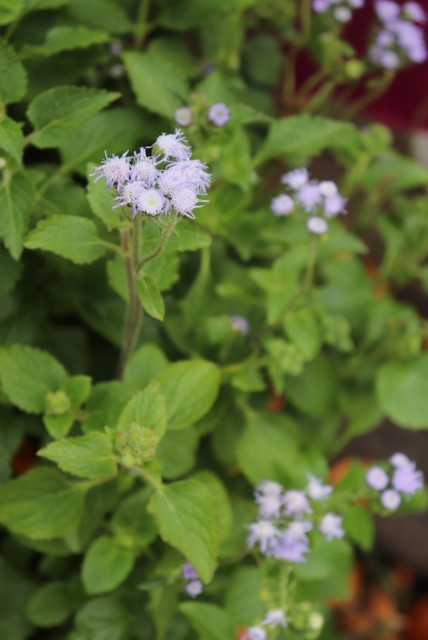
Ageratum ‘Old Grey’
These dense cushions of leaves are almost entirely hidden by long flowering from spring until early autumn, sometimes until first frosts. Many small downy heads, gathered 30 to 50 per terminal corymb, open profusely above foliage. Flowering lasts so long that it gave plant its name ageratum, from Greek meaning “that does not age”.
Flowers form small bright heads 2 to 5 cm in diameter. Ray florets, very tightly packed around a velvety, sometimes white, centre, have a delightfully feathery texture, making them look like little tufted daisies or tousled pom-poms. These mossy ball flowers appear in all shades of blue, from lavender-blue to powder-blue through violet-blue and purple. Some varieties offer white or pink-violet pom-poms (‘Royal Hawaii’) or even purplish-red blooms.
These flower clusters, which renew continuously up to onset of winter, are nectariferous; they attract butterflies, bumblebees and bees and promote pollination.
Fruits are small achenes, barely visible, turning black at maturity and containing seeds that rarely self-sow under our colder climates.
Flowers of long-stemmed varieties have excellent vase life and make generous country-style bouquets with very fresh colours.
Very little hardy, Ageratum is frost-tender below -5°C and can only overwinter outdoors in mild, maritime climates. It is a perennial most often grown in gardens as an annual. It grows in sun in humus-bearing, light, well-drained soil that remains cool throughout the season.
Mexican ageratum is indispensable in natural and romantic gardens, to which it always brings a bright, colourful note.
Compact, very floriferous clumps are perfect for composing charming scenes in front of annual flower beds and for flowering borders, window boxes and pots on terrace or balcony.

Close-up of an inflorescence of Ageratum
Main species and varieties with blue flowers
There are more than 40 species, including many small Ageratum with blue flowers, perfect for borders, and larger ones, ideal for structuring the foreground of beds and composing country-style bouquets. F1 hybrids are also very common in cultivation.
Most popular
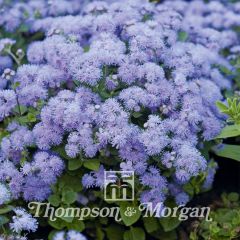
Ageratum Blue Danube F1
- Flowering time July to October
- Height at maturity 20 cm
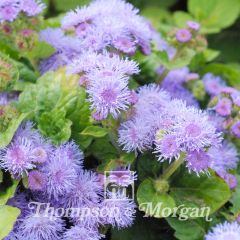
Ageratum houstonianum Blue Mink - Bluemink
- Flowering time July to October
- Height at maturity 30 cm
Our favourites
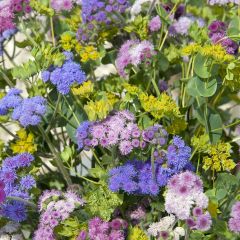
Ageratum houstonianum Timeless Mixed - Bluemink
- Flowering time July to October
- Height at maturity 45 cm
Discover other Ageratum seeds
View all →Available in 1 sizes
Available in 1 sizes
Available in 1 sizes
Available in 1 sizes
Available in 1 sizes
Available in 1 sizes
Available in 1 sizes
Sowing and planting ageratum
Where to plant ageratum or Mexican agerate?
From its South American origins, Ageratum from Mexico has retained a great sensitivity to cold. This perennial, not very hardy that cannot tolerate temperatures below -5°C will most often be cultivated as an annual in open ground or in a pot under our climate. In regions with mild winters or by the sea, it can remain in the ground all year round.
It needs a very sunny exposure to flower abundantly and light, well-drained soil, preferably calcareous. A good humus-bearing soil that is kept consistently moist will make it happy. It dislikes soils that are too dry and stagnant moisture.
It allows quick composition of country-style scenes in every corner of the garden, imparting a feeling of lightness. Tall varieties will structure
Dwarf varieties find their place in very sunny rockeries, pots and window boxes on a terrace or balcony.
When to sow and plant ageratum?
Ageratum seeds are sown under cover in warmth (15-18°C) from February to April, for transplanting into the garden in May. Ageratum in buckets are planted in spring, usually in May, once all risk of frost has passed. Follow our expert advice in our guide to succeed with your sowing of annual seeds!
How to sow ageratum seeds?
- Sow the ageratum seeds in buckets filled with a good seed compost
- Cover the seeds with a fine layer of potting soil
- Firm very lightly
- Place the sowing under a cloche or in a polyethylene bag
- Keep the substrate just moist until germination at a temperature of 20-30°C and in light
- Thin the seedlings then pinch regularly the tips of the stems to encourage the plant to branch
- When seedlings have strengthened, transplant into larger pots or directly into the garden once all risk of frost is removed
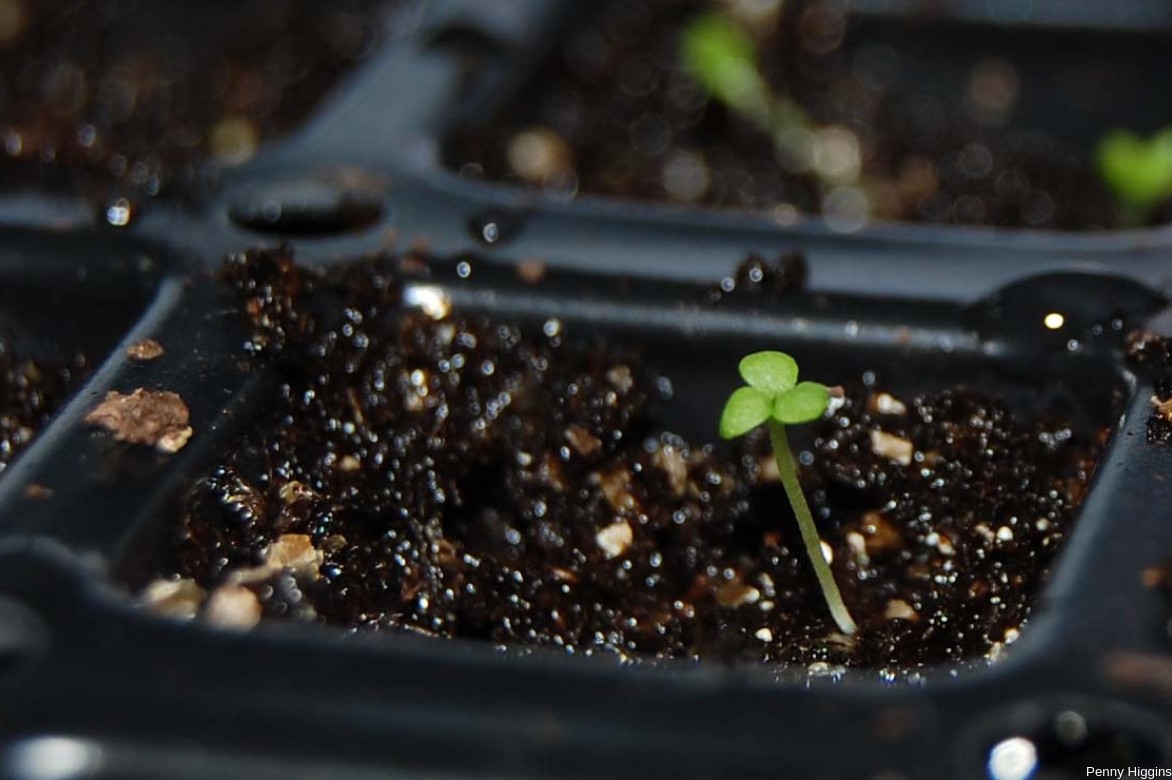
Ageratum sowing
How to plant ageratum?
In open ground
Space young plants 20 to 30 cm apart depending on variety. For good flowering, Mexican agerate will appreciate light soil: in heavy soils, improve drainage with a few handfuls of river sand. For a good massed effect, allow 5 to 8 young plants per m² depending on ripeness.
- Dig a hole two to three times wider than the rootball
- Lay a layer of gravel or clay pebbles at the bottom of the hole
- Plant the young plant of ageratum
- Backfill with garden soil mixed with a little compost
- Firm lightly and water abundantly
In a pot or planter
- Space seedlings 15-20 cm apart
- Spread a draining layer at the bottom of the container
- Plant in a soil-compost mix
- Water copiously
- Before putting pots outside, wait until all risk of frost has passed and water regularly in hot weather
Care and maintenance
Ageratummmexicanum is an annual plant that can be very floriferous without requiring much care provided the soil remains perfectly drained and cool in summer.
To flower well, it must be watered regularly, especially in dry weather: water without waterlogging the soil so that it never dries out completely. Excess moisture causes rot at the base.
Mulch to retain moisture at the base and reduce watering.
In a pot, water more often: avoid letting water stand in saucers. Use a liquid fertiliser for flowering plants in the water throughout the growth period.
Remove faded flowers regularly to encourage further flowering, and pinch stems regularly to promote branching.
In regions with mild winters, cut back clumps to ground level after flowering then spread a dry mulch (dry leaves) at the base to protect them from frost.
In cold regions where it is grown as an annual, in late autumn, pull up clumps of ageratum that will not survive severe frosts.
If you want to try to keep this tender perennial, move pots in at first frosts to a bright conservatory or a lightly heated greenhouse. You can take them out again in May, once temperatures have warmed, bearing in mind that ageratum will be more vulnerable to parasitic pests when grown indoors.
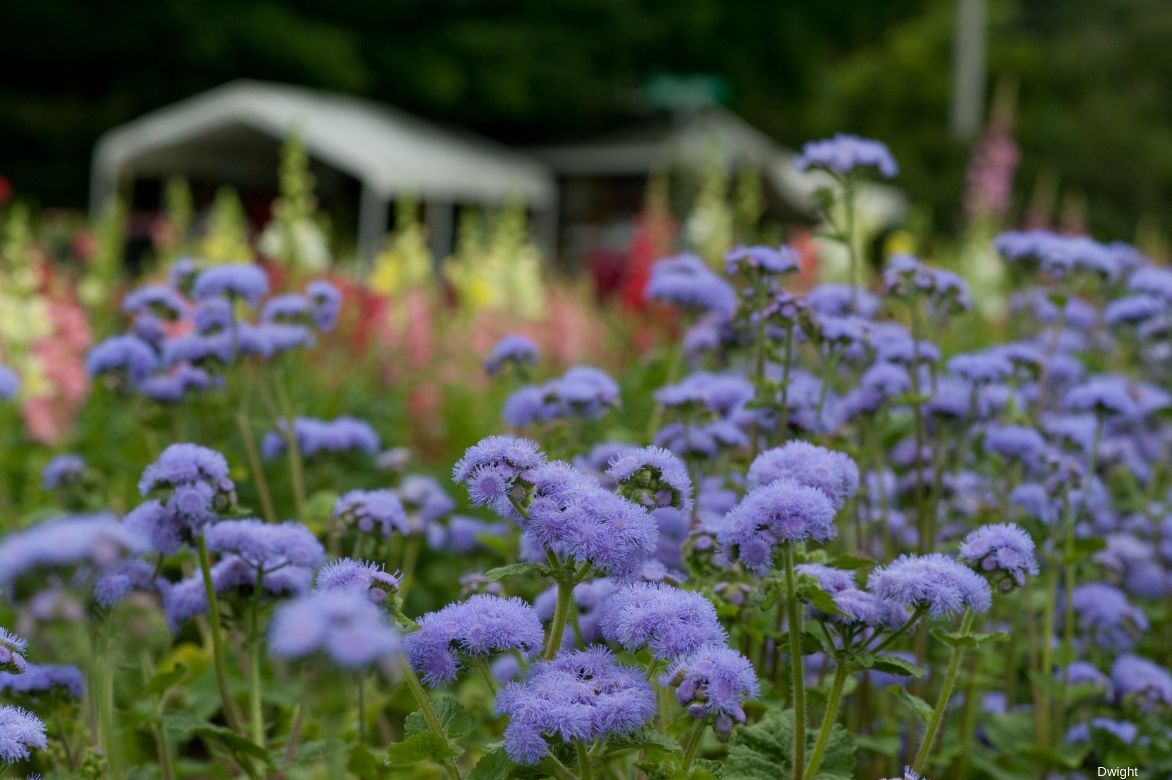
Potential diseases and pests
Rarely diseased, Ageratum can, however, be infested by red spider mites and aphids if soil is too dry : spray with water mixed with black soap.
Ageratums grown indoors in conservatories are often invaded by whiteflies, also called whiteflies especially when atmosphere is too dry : keep atmosphere sufficiently humid and well ventilated. To get rid of them : at first sign of infestation, spray a soapy solution made from black soap mixed with vegetable oil or nettle manure.
Young foliage is vulnerable to slugs and snails : discover our tips to fight their attacks!
In soil that is too wet, plant roots can rot : good drainage is essential to prevent disease.
Multiplication
Mexican ageratum is a tender perennial that can be propagated by cuttings, although success is not always guaranteed, we recommend raising young plants each yearfrom sowing with our ageratum seeds (follow our advice above).
Taking cuttings of ageratum
- In September, cut 10 cm lengths of stem without flowers
- Remove lower leaves from stems
- Plant in individual pots of turf and sand
- Place in a clear plastic bag to keep humid
- Protect from frost
- Plant out in spring, after frosts, once cuttings have sufficient roots
Companion plants for ageratum
In the garden, the light, bushy silhouette of Ageratum or Mexican ageratum allows many uses and combinations. This pretty annual plant thrives in gardens of every style to compose wild-looking scenes in a natural garden, to bring a touch of colour and softness to a romantic garden or a pink garden in mixes with other annuals and summer-flowering perennials.
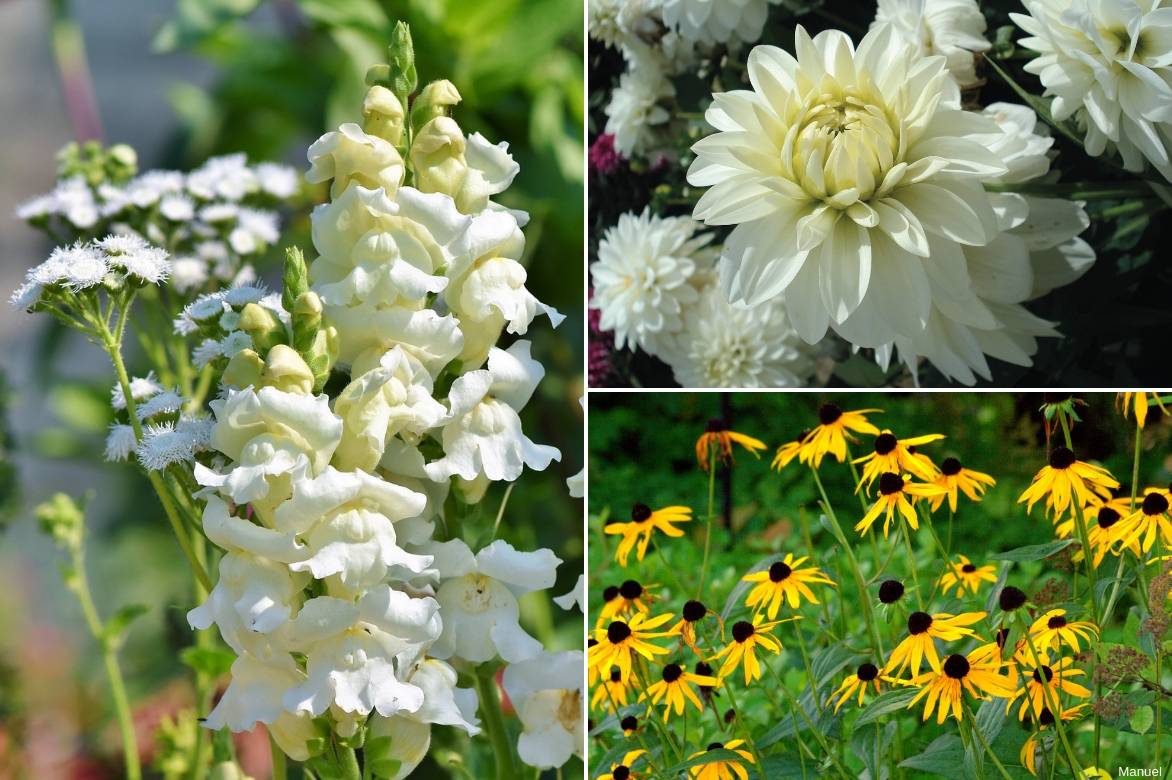
An idea for a combination: white Ageratum (or blue, such as ‘Horizon Bleu’ for example), Antirrhinum majus (such as ‘Royal Bride’), dwarf dahlia ‘Gallery Art Fair’ and rudbeckia (‘Goldsturm’ or ‘Early Bird Gold’)
Its tufted flowers most often display unrivalled shades of blue, making it a valuable plant in a blue garden.
In a very fresh composition, the large heads of ornamental Alliums, cleomes, cosmos, Ammi visnaga or toothpick plant will stand majestically above the dense, velvety cushions of Mexican ageratums.
Blue of Ageratum flowers offers a contrast with dandelion-yellow of calendula, nasturtiums, coreopsis, annual rudbeckias and yarrow in blue/yellow combinations.
Its colours, both delicate and deep, will set off plants with grey foliage such as nepeta or artemisia.
In a border or rockery, plant it in association with other low-growing plants such as salvia, lantanas, nemesia, alyssum, Peruvian heliotrope, and French marigolds.
In pots, it is a classic companion to begonias, fuchsias, bacopas, petunias, lobelias and impatiens.

An idea for a pot combination: Ageratum ‘Blue Mink’, Helichrysum petiolare ‘Silver’ and Petunia ‘Cascadias Rim Magenta’
Flowering of Asters and Alstroemeria will accompany it into autumn.
Useful resources
- Choose, plant and grow annuals: get plenty of ideas with our guides!
- Most beautiful annuals are in our nursery!
- Subscribe!
- Contents
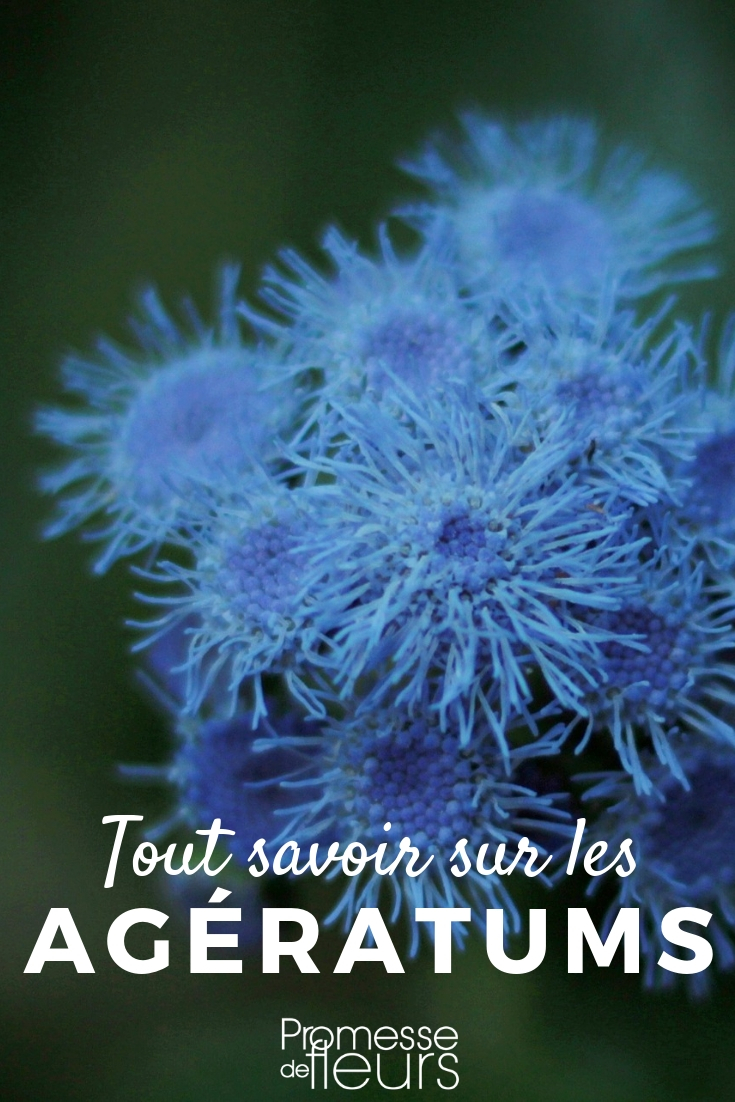
































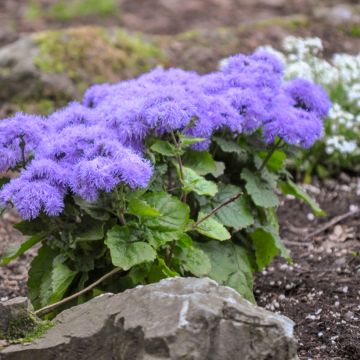

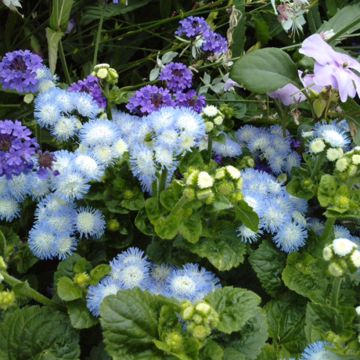
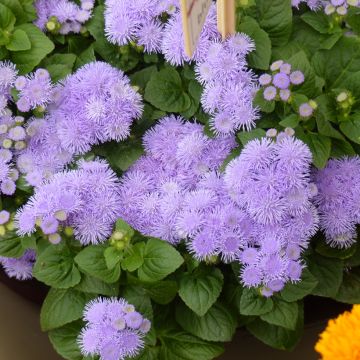
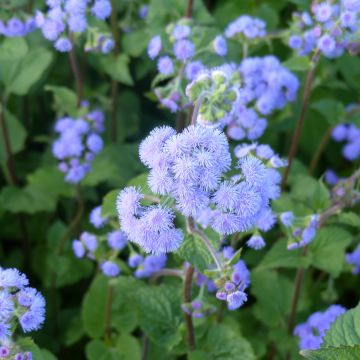

Comments